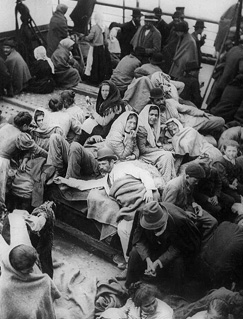industrialization & immigration
Overview
Newcomers were not always welcomed with open arms, however. Most groups experienced one form of prejudice or another upon arrival in the United States. This backlash against immigration came from nearly all sectors of American life. Labor unions, social organizations, politicians, religious factions — all would oppose immigration in one way or another. Indeed, such opposition eventually led to restrictions on certain groups, including a complete halt to Chinese immigration in 1882. Eventually, an annual quota system was adopted which limited the number of immigrants allowed to enter from particular countries.
One of the many destinations for these newcomers was the Connecticut River Valley. In particular, the areas around present-day Springfield and Holyoke quickly became home for new arrivals as well as centers for technological and industrial innovation. The newly built canals of Holyoke diverted water from the Connecticut River to power numerous mills and factories, all of which were in need of laborers. On the heights overlooking the river, the Springfield Armory served as a munitions factory from the time of the American Revolution through World War II. It was then that Franklin D. Roosevelt's executive order opened defense-industry jobs to African-American workers, thereby creating new opportunities for black workers to acquire valuable skills and earn better wages.
Numerous groups settled in the Springfield area, many in successive waves which often paralleled national immigration trends. Each of these groups came to the area as foreigners, each with unique histories and cultures. However, over time, these cultures and histories became intertwined, resulting in new cultural and social patterns that would come to define life in the Connecticut River Valley.
But these newcomers were viewed by many as little more than invading immigrant hordes that would ruin America's culture and society. The new immigrants' cultures, religions and customs were often regarded with disdain by Americans of Northern European ancestry like the English. For many, the immigrants' very existence was a direct challenge to notions of what it meant to be American.
However, despite the power of such sentiments, many of these groups left an indelible mark on the nation and its culture. Each brought unique social customs, religious beliefs, and world outlooks, which in turn contributed to the newly forming American culture. Indeed, this process of both cultural retention and cultural blending continues. Many of the fears exhibited by elites and the native-born during this era are similar to those proffered by opponents of immigration today. Yet, this continual reshaping of what it means to be an American is at the heart of our society and culture. A nation of immigrants, the United States is continually enriched and enhanced by these diverse cultures and peoples.
